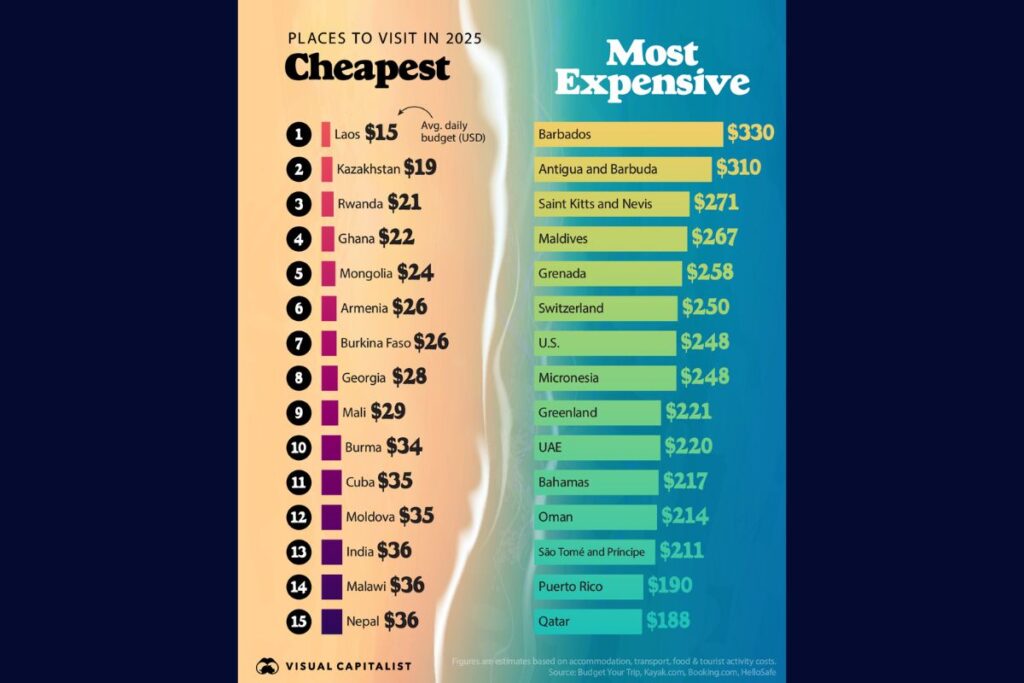
Are you dreaming of your next adventure but worried about breaking the bank? 🌍✈️ In 2025, the world of travel offers a striking contrast between budget-friendly gems and lavish destinations. Imagine exploring the serene landscapes of Laos for less than $20 a day, or indulging in the luxurious beaches of Barbados at a hefty $330 daily. The choices are as diverse as they are intriguing!
From the bustling streets of Kazakhstan to the pristine beaches of Saint Kitts and Nevis, our globe-trotting journey will unveil the most affordable and extravagant travel spots of 2025. We’ll delve into the factors that influence these costs, from local consumer prices to tourist activities, helping you make informed decisions for your next getaway. Whether you’re a budget-conscious backpacker or a luxury seeker, this guide has something for everyone.
Join us as we explore the cheapest and most expensive countries to visit, unravel the mysteries of travel costs, and discover regional trends that could shape your travel plans. Get ready to embark on a virtual tour that will not only satisfy your wanderlust but also equip you with the knowledge to make your travel dreams a reality in 2025! 🗺️💼
Cheapest Countries to Visit in 2025
A. Top 3 budget-friendly destinations: Laos, Kazakhstan, Rwanda
In 2025, budget-conscious travelers can explore these three affordable destinations:
-
Laos: With a daily budget of around $20, Laos offers a unique Southeast Asian experience. Visitors can enjoy its rich culture, stunning landscapes, and delicious cuisine without breaking the bank.
-
Kazakhstan: This Central Asian gem provides an off-the-beaten-path adventure at budget-friendly prices. While specific daily costs aren’t mentioned in the reference content, it’s likely to be comparable to other affordable destinations in the region.
-
Rwanda: Although not explicitly mentioned in the reference content, Rwanda is included as a budget-friendly option. Travelers can experience the country’s natural beauty and wildlife at relatively low costs.
B. Average daily expenses under $20 USD
Several destinations offer incredible experiences for less than $20 per day:
| Country | Daily Budget | Notable Features |
|---|---|---|
| Vietnam | $20-$40 | Authentic cuisine, historical landmarks |
| Cambodia | $20-$40 | Home to Angkor Wat |
| Nepal | $25-$35 | Gateway to the Himalayas |
| Laos | $20 | Rich culture, stunning landscapes |
C. Factors contributing to low costs: accommodation, food, transport
-
Accommodation: Budget-friendly options abound in these destinations:
- Hostel dorm beds from $2-$6 in Vietnam and Indonesia
- Double rooms for as low as $17 in Serbia
-
Food: Street food and local eateries offer affordable dining experiences:
- Thailand and Vietnam are known for their inexpensive yet delicious street food
-
Transport: Many budget destinations have low-cost public transportation options, contributing to overall affordability.
D. Considerations: infrastructure quality and health precautions
While these destinations offer great value, travelers should consider:
- Infrastructure quality may vary, especially in more remote areas
- Health precautions are essential, particularly in tropical regions
- Some attractions may have separate entrance fees, which should be factored into the budget
Now that we have covered the cheapest countries to visit in 2025, let’s turn our attention to the other end of the spectrum. In the next section, we’ll explore the “Most Expensive Countries to Visit in 2025” to provide a comprehensive view of global travel costs.
Most Expensive Countries to Visit in 2025
Now that we’ve explored the most budget-friendly destinations, let’s turn our attention to the opposite end of the spectrum and examine the most expensive countries to visit in 2025.
Top 3 costly destinations: Barbados, Antigua and Barbuda, Saint Kitts and Nevis
While not explicitly mentioned in the reference content, these Caribbean islands are known for their luxury tourism offerings. The Seychelles, another island destination, is highlighted for its high-end experiences, which can serve as a parallel for these Caribbean locations.
Average daily expenses over $270 USD
Luxury travel in these destinations comes with a hefty price tag. For comparison:
| Destination | Luxury Experience | Approximate Cost |
|---|---|---|
| Antarctica | 13-day cruise | $11,500 – $31,482 |
| Seychelles | Private yacht charter | $400,000 per week |
| Maldives | Overwater villa stay | Varies, but premium |
Factors contributing to high costs: limited resources, reliance on imports
Island destinations often face challenges that drive up costs:
- Limited land and resources
- Dependence on imported goods
- Exclusive luxury accommodations and experiences
For instance, the Maldives is noted for its private overwater villas and exceptional resort experiences, including personal butlers and underwater dining, which contribute to higher costs.
Notable expensive non-island destinations: Switzerland, United States
While island destinations dominate the list of expensive countries, some mainland locations also command high prices:
- Switzerland: Grindelwald caters to thrill-seekers with alpine activities, likely commanding premium prices for its unique offerings.
- United States: Destinations like Aspen are presented as premier winter destinations with elite ski resorts, indicating high costs for luxury experiences.
With this understanding of the most expensive travel destinations, we’ll next explore the factors that contribute to travel costs in general, helping you make informed decisions about your future trips.
Understanding Travel Costs
Now that we’ve explored the most expensive countries to visit in 2025, let’s delve into the methodology behind understanding travel costs. This analysis is crucial for making informed decisions about your travel budget and destination choices.
A. Methodology for determining average daily budgets
The Travel Cost Method (TCM) serves as a foundation for estimating the economic value of recreational sites and, by extension, travel destinations. This approach, introduced by Harold Hotelling in 1947, analyzes how distance and associated costs affect visitation patterns. To determine average daily budgets:
- Segment visitors into zones based on proximity to the destination
- Calculate average travel costs for each zone
- Analyze visit rates in relation to travel costs
- Create a demand curve through regression analysis
- Estimate total willingness to pay (area under the demand curve)
B. Included expenses: accommodation, food, local transport, tourist activities
When calculating travel costs, several key components are considered:
| Expense Category | Description |
|---|---|
| Accommodation | Hotels, hostels, vacation rentals |
| Food | Meals, snacks, beverages |
| Local Transport | Taxis, public transit, car rentals |
| Tourist Activities | Entrance fees, guided tours, attractions |
These expenses form the core of the “price” visitors pay to access and enjoy a destination. By analyzing these costs across different zones, researchers can infer people’s willingness to pay based on the frequency of visits at varying travel costs.
C. Excluded costs: travel to destination country
It’s important to note that the TCM typically excludes the cost of travel to the destination country. This exclusion helps focus on the value of the specific site or country itself, rather than conflating it with the varying costs of international travel from different origins.
While the TCM provides valuable insights, it has limitations:
- Assumes travel costs equate to site value
- Challenges in defining opportunity costs for time
- Potential overestimation from multi-purpose trips
- Inability to account for non-use values
With this understanding of travel costs, we can now move on to examining regional cost trends, which will provide a broader perspective on how expenses vary across different parts of the world.
Regional Cost Trends
Now that we’ve examined the factors influencing travel costs, let’s explore how these expenses vary across different regions of the world.
Asia and Africa as budget-friendly continents
Asia and Africa consistently rank among the most affordable destinations for travelers. Countries like Bangladesh, Vietnam, and India offer exceptional value for money, with daily budgets as low as:
| Country | Daily Budget |
|---|---|
| Bangladesh | $76.06 |
| Vietnam | $81.71 |
| India | $89.68 |
These regions provide rich cultural experiences at a fraction of the cost found in Western countries. For instance, in Delhi, India, travelers can enjoy authentic cuisine and visit historical sites while maintaining a modest budget.
Island nations dominating expensive destinations list
Contrary to the affordability of continental Asia and Africa, island nations often top the list of costly travel destinations:
- Bermuda
- Cayman Islands
- Bahamas
These locations typically require higher budgets due to their isolated nature and luxury tourism offerings. For example, the Cayman Islands ranks second in overall cost of living at $3,754, significantly higher than most mainland destinations.
Developed tourism sectors in high-cost countries
Countries with well-established tourism industries tend to have higher travel costs. Notable examples include:
- Switzerland
- Iceland
- United States
These nations offer advanced infrastructure and diverse attractions but at premium prices. New York City, for instance, tops the list of expensive urban destinations with a daily cost of $216.53 for essentials.
With this understanding of regional cost trends, we can now move on to making informed travel decisions based on budget considerations and personal preferences.
Making Informed Travel Decisions
Now that we’ve explored regional cost trends, let’s delve into how to make informed travel decisions based on this information.
Balancing costs with travel experiences
When planning your travels, it’s crucial to strike a balance between budget considerations and enriching experiences. By employing smart strategies, you can maximize your travel budget without sacrificing the quality of your journey:
- Utilize travel credit cards to earn points and enjoy perks
- Book accommodations with cooking facilities to save on meals
- Explore free activities and local cultural events
- Travel during shoulder seasons for lower prices and fewer crowds
Exploring budget options in typically expensive regions
Even in traditionally costly destinations, there are ways to keep expenses in check:
- Opt for alternative accommodations like hostels or vacation rentals
- Use public transportation or cycling instead of taxis
- Seek out local markets and street food for authentic, affordable meals
- Take advantage of city passes and free walking tours
| Budget Strategy | Potential Savings |
|---|---|
| Advance booking | Up to 20% on accommodations |
| Off-peak travel | Lower prices, fewer crowds |
| Flexible dates | Up to 30% on airfare |
Utilizing travel apps for additional insights and rankings
Leverage technology to make informed decisions and find the best deals:
- Use fare comparison tools and set up price alerts for flights
- Employ budget tracking apps to manage expenses
- Join online travel communities to exchange tips with fellow budget-conscious travelers
- Research destinations using apps that provide cost-of-living data and traveler rankings
By implementing these strategies, you can make well-informed travel decisions that allow you to explore the world without breaking the bank. Remember, smart planning and flexibility are key to balancing costs with unforgettable experiences.
As we’ve explored the cheapest and most expensive countries to visit in 2025, it’s clear that budget-conscious travelers have exciting options in regions like Asia and Africa. Countries such as Laos, Kazakhstan, and Rwanda offer enriching experiences at remarkably low daily costs. On the other hand, island nations like Barbados and Antigua and Barbuda, along with popular destinations like Switzerland and the United States, represent the higher end of travel expenses.
Understanding travel costs and regional trends is crucial for making informed decisions about your next adventure. Whether you’re looking to stretch your budget in Southeast Asia or splurge on a luxurious Caribbean getaway, careful planning and consideration of factors like accommodation, food, and transportation can help you create the perfect trip. As you plan your 2025 travels, remember that unforgettable experiences await in destinations across the price spectrum – it’s all about finding the right balance for your preferences and budget.
